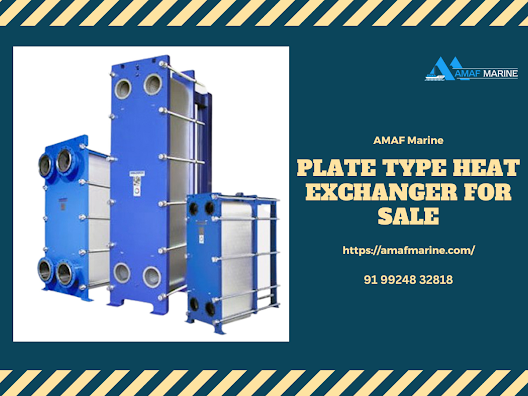A system that moves heat from one fluid to another is a heat exchanger. It can be used in both heating and cooling processes. The Heat Exchanger is the primary support system for all of the vessel's machinery, cooling or heating the fluid as needed.
Fluid can be either liquid or gas. The two most common types of heat exchangers used in the industry are Shell & Tube Type Heat Exchanger And Plate Type Heat Exchanger. Marine offers Plate Type Heat Exchanger for Sale for a wide range of industries and applications, including heating, cooling, heat recovery, condensation, and evaporation.
Plate Type Heat Exchanger
Multiple heat transfer plates make up a plate heat exchanger (PHE). A fixed plate and a loose pressure plate hold the unit together. Each heat transfer plate has a gasket arrangement that creates two distinct channel systems. The purpose of a plate heat exchanger is to transfer heat energy from one fluid to another.
Because the heat exchanger separates them, these fluids never come into contact. Welded, semi welded, and brazed heat exchangers are used for high pressure fluid heat exchange or where a more compact product is required.
A plate heat exchanger cuts heat through the surface, separating the hot medium from the cold. As a result, heating and cooling fluids and gases consume very little energy. Heat is always transferred from a hot medium to a cold medium, according to the theory of heat transfer between mediums and fluids.
Why Are Plate Heat Exchangers The Best?
A plate heat exchanger is the most cost effective option because it can achieve high heat transfer coefficients with pure countercurrent flow, resulting in the most efficient heat transfer and the smallest surface area. The cost of maintenance is also reasonable, especially when compared to scraped surface heat exchangers.
Since there is such a thin layer of fluid passing through each plate, less energy is needed to transfer heat than there would be in a boiler. Each plate's troughs go a step further and separate the fluids into smaller channels, increasing the turbulent flow.
Shop At AMAF Marine
AMAF Marine specializes in used and reconditioned heat exchangers, as well as their spares. Before being supplied to customers, each spare is subjected to a thorough quality check and examination. When your entire set of machinery is stuck due to a shortage in any of your spares, time is of the essence, and we can assist you by providing timely delivery and keeping your machinery moving without any unnecessary delay.
We deal in a variety of Heat Exchanger components that include Inlet & Outlet pipes, Gaskets, Plates, Carry Bars, Clamping Bolts, Guide bars, Frame Plates, and Pressure Plates. AMAF Marine’s innovative solutions are sustainable. To ensure energy efficiency, emission reduction, and recovery of waste and water, we always optimize technology for the best. AMAF
Do You Need Hydraulic Pumps?
A hydraulic pump turns mechanical energy into fluid power. It is used in hydraulic systems to accomplish tasks like lifting heavy loads in excavators or jacks to being used in hydraulic splitters. AMAF Marine also offers the best Hydraulic Pump for Sale Naniwa products.
A plate heat exchanger (PHE) includes several heat transfer plates. It is a complete unit held by a fixed and loose pressure plate. Each heat transfer plate has a gasket arrangement that creates two distinct channel systems.
The arrangement of the Gaskets for Heat Exchanger allows for single channel flow. This allows the primary and secondary media to flow in a counter current manner. Because of the gasket design, the mediums are not mixed. As the fluids flow through the unit, the corrugated plates create turbulence. Turbulence results in an effective heat transfer coefficient.

Comments
Post a Comment